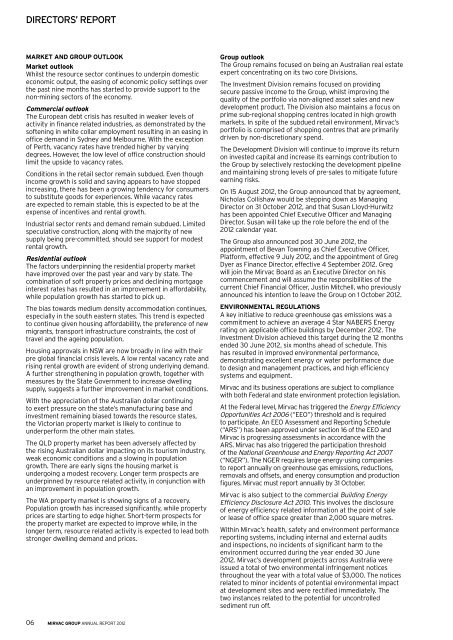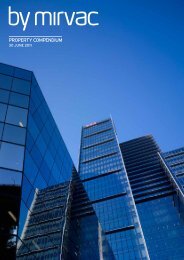MIRVAC gRoup AnnuAl RepoRt 2012 - Mirvac - Mirvac Group
MIRVAC gRoup AnnuAl RepoRt 2012 - Mirvac - Mirvac Group
MIRVAC gRoup AnnuAl RepoRt 2012 - Mirvac - Mirvac Group
You also want an ePaper? Increase the reach of your titles
YUMPU automatically turns print PDFs into web optimized ePapers that Google loves.
DIReCtoRs’ <strong>RepoRt</strong><br />
MARKet AnD <strong>gRoup</strong> outlooK<br />
Market outlook<br />
whilst the resource sector continues to underpin domestic<br />
economic output, the easing of economic policy settings over<br />
the past nine months has started to provide support to the<br />
non-mining sectors of the economy.<br />
commercial outlook<br />
The european debt crisis has resulted in weaker levels of<br />
activity in finance related industries, as demonstrated by the<br />
softening in white collar employment resulting in an easing in<br />
office demand in Sydney and Melbourne. with the exception<br />
of Perth, vacancy rates have trended higher by varying<br />
degrees. however, the low level of office construction should<br />
limit the upside to vacancy rates.<br />
Conditions in the retail sector remain subdued. even though<br />
income growth is solid and saving appears to have stopped<br />
increasing, there has been a growing tendency for consumers<br />
to substitute goods for experiences. while vacancy rates<br />
are expected to remain stable, this is expected to be at the<br />
expense of incentives and rental growth.<br />
Industrial sector rents and demand remain subdued. Limited<br />
speculative construction, along with the majority of new<br />
supply being pre-committed, should see support for modest<br />
rental growth.<br />
Residential outlook<br />
The factors underpinning the residential property market<br />
have improved over the past year and vary by state. The<br />
combination of soft property prices and declining mortgage<br />
interest rates has resulted in an improvement in affordability,<br />
while population growth has started to pick up.<br />
The bias towards medium density accommodation continues,<br />
especially in the south eastern states. This trend is expected<br />
to continue given housing affordability, the preference of new<br />
migrants, transport infrastructure constraints, the cost of<br />
travel and the ageing population.<br />
housing approvals in NSw are now broadly in line with their<br />
pre global financial crisis levels. A low rental vacancy rate and<br />
rising rental growth are evident of strong underlying demand.<br />
A further strengthening in population growth, together with<br />
measures by the State Government to increase dwelling<br />
supply, suggests a further improvement in market conditions.<br />
with the appreciation of the Australian dollar continuing<br />
to exert pressure on the state’s manufacturing base and<br />
investment remaining biased towards the resource states,<br />
the victorian property market is likely to continue to<br />
underperform the other main states.<br />
The qLD property market has been adversely affected by<br />
the rising Australian dollar impacting on its tourism industry,<br />
weak economic conditions and a slowing in population<br />
growth. There are early signs the housing market is<br />
undergoing a modest recovery. Longer term prospects are<br />
underpinned by resource related activity, in conjunction with<br />
an improvement in population growth.<br />
The wA property market is showing signs of a recovery.<br />
Population growth has increased significantly, while property<br />
prices are starting to edge higher. Short-term prospects for<br />
the property market are expected to improve while, in the<br />
longer term, resource related activity is expected to lead both<br />
stronger dwelling demand and prices.<br />
06 mirvac group annual report <strong>2012</strong><br />
group outlook<br />
The <strong>Group</strong> remains focused on being an Australian real estate<br />
expert concentrating on its two core Divisions.<br />
The Investment Division remains focused on providing<br />
secure passive income to the <strong>Group</strong>, whilst improving the<br />
quality of the portfolio via non-aligned asset sales and new<br />
development product. The Division also maintains a focus on<br />
prime sub-regional shopping centres located in high growth<br />
markets. In spite of the subdued retail environment, <strong>Mirvac</strong>’s<br />
portfolio is comprised of shopping centres that are primarily<br />
driven by non-discretionary spend.<br />
The Development Division will continue to improve its return<br />
on invested capital and increase its earnings contribution to<br />
the <strong>Group</strong> by selectively restocking the development pipeline<br />
and maintaining strong levels of pre-sales to mitigate future<br />
earning risks.<br />
on 15 August <strong>2012</strong>, the <strong>Group</strong> announced that by agreement,<br />
Nicholas Collishaw would be stepping down as Managing<br />
Director on 31 october <strong>2012</strong>, and that Susan Lloyd-hurwitz<br />
has been appointed Chief executive officer and Managing<br />
Director. Susan will take up the role before the end of the<br />
<strong>2012</strong> calendar year.<br />
The <strong>Group</strong> also announced post 30 June <strong>2012</strong>, the<br />
appointment of Bevan Towning as Chief executive officer,<br />
Platform, effective 9 July <strong>2012</strong>, and the appointment of Greg<br />
Dyer as Finance Director, effective 4 September <strong>2012</strong>. Greg<br />
will join the <strong>Mirvac</strong> Board as an executive Director on his<br />
commencement and will assume the responsibilities of the<br />
current Chief Financial officer, Justin Mitchell, who previously<br />
announced his intention to leave the <strong>Group</strong> on 1 october <strong>2012</strong>.<br />
enviRonMentAl RegulAtions<br />
A key initiative to reduce greenhouse gas emissions was a<br />
commitment to achieve an average 4 Star NABeRS energy<br />
rating on applicable office buildings by December <strong>2012</strong>. The<br />
Investment Division achieved this target during the 12 months<br />
ended 30 June <strong>2012</strong>, six months ahead of schedule. This<br />
has resulted in improved environmental performance,<br />
demonstrating excellent energy or water performance due<br />
to design and management practices, and high efficiency<br />
systems and equipment.<br />
<strong>Mirvac</strong> and its business operations are subject to compliance<br />
with both Federal and state environment protection legislation.<br />
At the Federal level, <strong>Mirvac</strong> has triggered the energy efficiency<br />
opportunities Act 2006 (“eeo”) threshold and is required<br />
to participate. An eeo Assessment and Reporting Schedule<br />
(“ARS”) has been approved under section 16 of the eeo and<br />
<strong>Mirvac</strong> is progressing assessments in accordance with the<br />
ARS. <strong>Mirvac</strong> has also triggered the participation threshold<br />
of the National Greenhouse and energy Reporting Act 2007<br />
(“NGeR”). The NGeR requires large energy-using companies<br />
to report annually on greenhouse gas emissions, reductions,<br />
removals and offsets, and energy consumption and production<br />
figures. <strong>Mirvac</strong> must report annually by 31 october.<br />
<strong>Mirvac</strong> is also subject to the commercial Building energy<br />
efficiency Disclosure Act 2010. This involves the disclosure<br />
of energy efficiency related information at the point of sale<br />
or lease of office space greater than 2,000 square metres.<br />
within <strong>Mirvac</strong>’s health, safety and environment performance<br />
reporting systems, including internal and external audits<br />
and inspections, no incidents of significant harm to the<br />
environment occurred during the year ended 30 June<br />
<strong>2012</strong>. <strong>Mirvac</strong>’s development projects across Australia were<br />
issued a total of two environmental infringement notices<br />
throughout the year with a total value of $3,000. The notices<br />
related to minor incidents of potential environmental impact<br />
at development sites and were rectified immediately. The<br />
two instances related to the potential for uncontrolled<br />
sediment run off.




